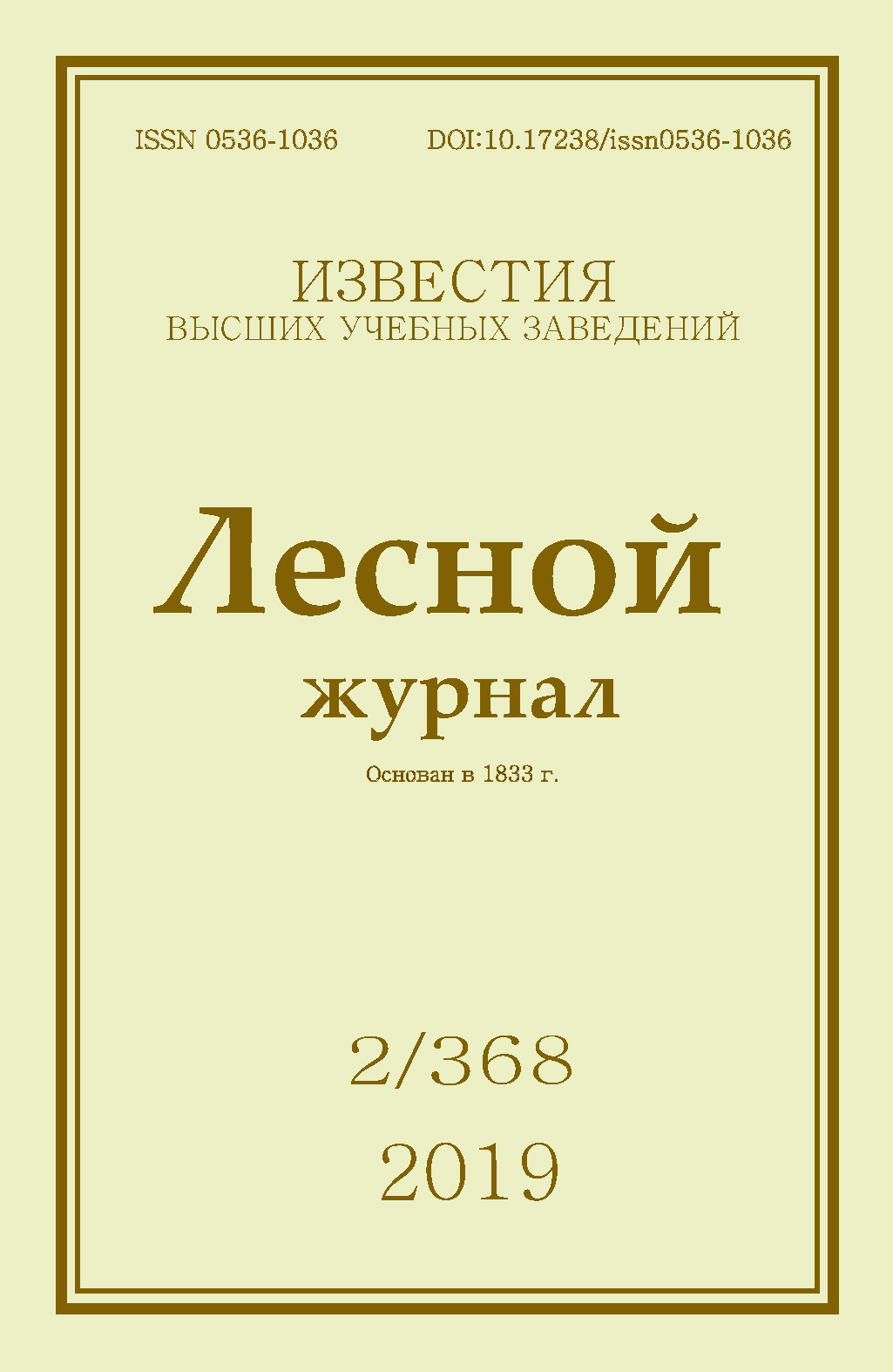Resin Productivity of Pine after Partial Logging on the Hydrotechnical Reclamation Site
DOI:
https://doi.org/10.17238/issn0536-1036.2019.2.67Keywords:
pine tapping, hydrotechnical reclamation, partial logging, environmental factors, diagnosis of pine treesAbstract
Integrated use of coniferous forest resources is a natural necessity of sustainable environment conservancy. Hydrological forest reclamation systems in coniferous boreal forests imply the development of specific management regime including silvicultural tending and partial logging. Spectrum broadening of products obtained in forest land exploitation should be achieved by the means of lifetime and minor use. Production of pine turpentine (sap) allows to obtain valuable forest chemical raw materials for the number of industries. Influence of forest drainage and partial logging on resin productivity is one of the insufficiently provided research issues in forestry. On the example of Sokol’skiy District of Vologda Region, the influence of location of pine trees (towards the channels of regulating network and forest belts), left for completion of growing after partial logging, on the pine sap exudation under closed tapping was studied. It was established that the drainage system channels in the felling site area were in satisfactory condition from 1972 till 2015. The highest resin productivity of pine forests was observed in July and the lowest in August. One of the forest belts had the highest resin productivity in the center and at the edge of the swath in 2013 and 2015; and in the channel area in 2013 and 2014. Resin productivity at the felling site is 1.4 times higher than in the control area (under the drainage conditions). This proves the positive effect from selective tree cutting in logging for resin exudation from the part of trees remained after tapping. Three years of studies have shown that the variability of resin exudation at the edge of the swath is 9 % less than in the center of the swath. No apparent fluctuations have been found in the channel and interchannel areas of the drained belt. The study has proved that soil and air temperature, and valuation diameter of sample trees involved into tapping can affect the resin exudation. A significant correlation with the temperature of underlying surface was registered in July and August and with the soil temperature in July. The air temperature at the level of resin blaze location of the sample trees affects the resin exudation mostly in June. It turned out that the correlation between resin exudation and valuation diameter of trees is stronger in the channel area and at the edge of swath than in the center of interchannel area. Probably, it depends on the microclimate and hydrological features after draining and partial logging that results in more comfortable conditions for growth (higher illumination). The turpentine production in drained pine forests requires carrying out partial cuttings of moderate intensity by reserves and intensive tapping at the edges of belts (logging area) left for completion of growing. In drained pine forests on peat soils, tapping with greater intensity should be carried out in the channel areas (along the drainage channels).
For citation: Novoselov A.S. Resin Productivity of Pine after Partial Logging on the Hydrotechnical Reclamation Site. Lesnoy Zhurnal [Forestry Journal], 2019, no. 2, pp. 67–77. DOI: 10.17238/issn0536-1036.2019.2.67
Downloads
References
Дружинин Н.А. Лесоводственно-экологическое обоснование ведения лесного хозяйства в осушаемых лесах: дис. … д-ра. с.-х. наук. СПб., 2006. 348 с.
Дружинин Н.А., Дружинин Ф.Н., Пестовский А.С., Новосёлов А.С. Прижизненное и побочное пользования осушаемых лесов Вологодской области: моногр. / под общ. ред. А.С. Новосёлова. Вологда: ИЦ ВГМХА, 2011. 192 с.
Лесотаксационный справочник для северо-востока европейской части СССР (нормативные материалы для Архангельской, Вологодской областей и Коми АССР). Архангельск: АИЛиЛХ, 1986. 358 с.
Мелехов И.С. Лесоводство: учеб. М.: МГУЛ, 2003. 320 с.
Новосёлов А.С., Дружинин Н.А. Сезонная динамика смолопродуктивности осушаемых сосновых древостоев // Лесн. журн. 2017. № 1. С. 21–29. (Изв. высш. учеб. заведений). DOI: 10.17238/issn0536-1036.2017.1.21
ОCТ 13-80–79. Подсочка сосны. Термины и определения / Мин-во лесн. и деревообраб. пром-сти СССР. Введ. 1980-07-01. М., 1979. 22 с.
Пастухова Н.О. Критерии смолопродуктивности сосновых древостоев: автореф. дис. … канд. с.-х. наук. Архангельск, 2017. 20 с.
Петрик В.В. Лесоводственные методы повышения смолопродуктивности сосновых древостоев. Архангельск: АГТУ, 2004. 236 с.
Практическая гидролесомелиорация / под ред. В.К. Константинова. СПб.: СПбНИИЛХ, 2005. 128 с.
Чудный А.В. Рубки ухода на селекционной основе как метод формирования высокосмолопродуктивных насаждений сосны // Лесн. хоз-во. 1969. № 6. С. 65–67.
Albaugh T.J., Fox T.R., Allen H.L., Rubilar R.A. Juvenile Southern Pine Response to Fertilization Is Influenced by Soil Drainage and Texture // Forests. 2015. Vol. 6, iss. 8. Pp. 2799–2819. DOI: 10.3390/f6082799
Arano K.G., Munn I.A. Evaluating Forest Management Intensity: A Comparison among Major Forest Landowner Types // Forest Policy and Economics. 2006. Vol. 9, iss. 3. Pp. 237–248. DOI: 10.1016/j.forpol.2005.07.011
Helming K., Tscherning K., König B., Sieber S., Wiggering H., Kuhlman T., Wascher D., Perez-Soba M., Smeets P., Tabbush P., Dilly O., Hüttl R.F., Bach H. Ex Ante Impact Assessment of Land Use Change in European Regions – The SENSOR Approach // Sustainability Impact Assessment of Land Use Changes. Berlin: Springer, 2008. Pp. 77–105.
Hengeveld G.M., Nabuurs G.-J., Didion M., Van den Wyngaert I., Clerkx A.P.P.M., Schelhaas M.-J. A Forest Management Map of European Forests // Ecology and Society. 2012. Vol. 17, no. 4. Article no. 53. DOI: 10.5751/ES-05149-170453
Punttila P., Autio O., Kotiaho J.S., Kotze D.J., Loukola O.J., Noreika N., Vuori A., Vepsäläinen K. The Effects of Drainage and Restoration of Pine Mires on Habitat Structure, Vegetation and Ants // Silva Fennica. 2016. Vol. 50, no. 2. 31 p. DOI: 10.14214/sf.1462







